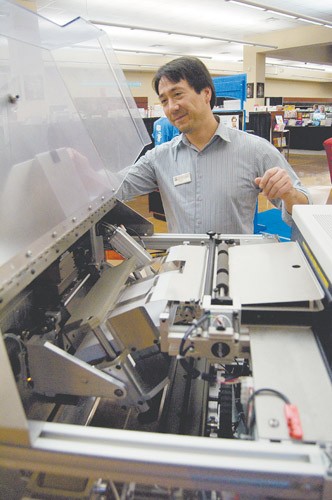The UofA Bookstore has a new machine that the staff hopes will make acquiring textbooks cheaper and more environmentally friendly.
The bookstore received an Espresso Book Machine 2.0 from On Demand Books in October. Espresso means “”something made to order, one at a time, at point of sale, quickly,”” according to the company’s Web site.
The UA was the second buyer of this machine in the United States, after the University of Missouri Bookstore.
The machine can print, bind and cut paperback books. The press is made up of three components: a standard laser printer that produces the book block, or pages of the book, a cover printer that produces the cover of the book and the core unit that puts it all together.
“”The main reason we got it is because we’re hoping to try and be able to negotiate with publishing companies and be able to print textbooks at a lower cost,”” said Chris Schafer, faculty relations representative with UA BookStores.
Currently, Schafer is in negotiations with publishers, and the bookstore hopes to start printing a small number of textbooks with the machine next semester. Over time, he believes more titles will become available for bookstore staff to print themselves. This can limit the environmental impact of obtaining textbooks, because the publisher does not have to ship the books to the bookstore, Schafer said.
“”The other cool thing about on-demand printing is it takes that guesswork out,”” he said. “”We don’t have to waste money on bringing in books that people won’t buy, and we don’t have to worry we’re going to run out of the books, because we can just make more if we need them.””
To print a book, someone must first select the title from the computer. From there, the pages of the book feed into the core unit from one side, and the cover feeds in from the opposite side. Once all of the pages of the book have printed, the machine clamps them together and rotates them so the spine faces down toward the cover.
Next, a cylinder with melted glue rolls down the spine, and the book block is clamped onto the cover to bind the book. Finally, the machine cuts the top, bottom and leading edge of the book to make it the correct size. All of the excess paper is recycled.
“”What you end up with is really, I think, a book that is indistinguishable from a book that was produced under traditional methods of publishing,”” Schafer said.
The cost of running the machine is about one cent per page, and the press itself cost $97,500, plus the price of the printers.
Currently, Schafer is trained to run the press. Eventually, he hopes to have students who are interested in engineering, printing, books or graphic design to help run the press and design book covers.
The University of Arizona University Libraries and the UA Press are partnering with the bookstore in the usage of the press. These organizations will use the Espresso Book Machine 2.0 to produce titles that are no longer in print.
“”It’s kind of bringing books back to life,”” Schafer said. “”Giving new life to those books that are no longer in print is something that I think is really worthwhile.””
The software that comes with the machine also provides more than 4 million general book titles that students will be able to request if the bookstore does not carry them.
The bookstore also hopes to print books for self-publishing authors. Larger publishingcompanies usually have a minimum number of books the author must purchase, but with the Espresso Book Machine 2.0, authors can print the number they need.
Roberto Rodriguez, an assistant professor in the Mexican American studies department, will use the press to print one of his books.
Rodriguez wrote “”Assault With a Deadly Weapon”” about his experience as a journalist reporting about police brutality in Los Angeles in 1979. About 2,000 copies of the book were published in 1984. Now people ask Rodriguez for copies of his book, but they are difficult to find.
“”I guess people have them but they’re really not available anywhere,”” he said.
Rodriguez said that by using the Espresso Book Machine 2.0, he doesn’t have to print 100 or 1,000 copies of the book.
“”It’s like takeout,”” he said about the ability to order books on-demand.
“”It’s almost like magic because a book can be printed in five minutes,”” he said. “”I’m reliving a part of my old world by seeing this book come back to life.””









